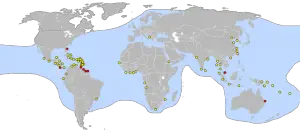The leatherback sea turtles are highly migratory species. They tend to migrate longest distances among all marine turtles. They are known to swim around 3,700 miles each way from the foraging ground to the breeding site.
Leatherback Sea Turtle Habitat
Leatherbacks are essentially pelagic turtles but they also frequent coastal waters for feeding. Leatherbacks are found in tropical and subtropical waters around the world.
They are the only reptiles in the world that live under 40 degrees Fahrenheit because no other reptilian relative can survive at such low temperatures. They can dive down to a depth of 1,000 meters in pursuit of its prey. No other tetrapod can even think about diving so deep into the ocean.
The Pacific leatherbacks undertake long trans-Pacific migrations from their nesting sites to foraging grounds. These turtles swim 7,000 miles from the Western Pacific like Solomon Islands and Papua New Guinea to the eastern North Pacific in about 10 to 12 months.
Leatherback Sea Turtle Distribution
 In reptiles, the leatherbacks are the most widely distributed species of turtles. The range of these turtles extend far toward Alaska, Norway and even up to the Arctic Circle to the north, while they are found as far south as Cape Agulhas, which is the southern tip of Africa. The distinct populations of leatherbacks are present across the eastern and western Pacific and the Atlantic viz. Atlantic leatherbacks and Pacific leatherbacks.
In reptiles, the leatherbacks are the most widely distributed species of turtles. The range of these turtles extend far toward Alaska, Norway and even up to the Arctic Circle to the north, while they are found as far south as Cape Agulhas, which is the southern tip of Africa. The distinct populations of leatherbacks are present across the eastern and western Pacific and the Atlantic viz. Atlantic leatherbacks and Pacific leatherbacks.
In South America, the most famous nesting grounds of the Atlantic leatherbacks are Guiana, Republic of Suriname and Guyana. In Central Africa, the significant nesting sites are Gabon, Caribbean and Trinidad and Tobago. Every year, about 30,000 leatherbacks come to the nesting beaches at Mayumba National Park in Gabon, making it the largest cluster of leatherbacks worldwide.
The leatherbacks of the Pacific are subdivided into further two subpopulations. One of the Pacific leatherbacks has nesting sites on the sandy beaches of Solomon Islands, Indonesia and Papua while the other leatherbacks nest on beaches of Nicaragua, Mexico, El Salvador, Costa Rica and Panama.
Sources:
“Leatherback Turtles”. NOAA Fisheries
“Leather Sea Turtle”. Encyclopedia of Life
“Information About Sea Turtles: Leatherback Sea Turtle”. Sea Turtle Conservancy
“Leatherback Sea Turtle”. National Geographic











